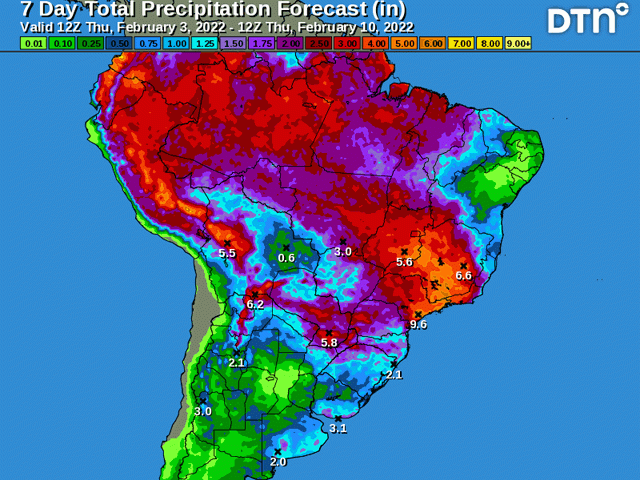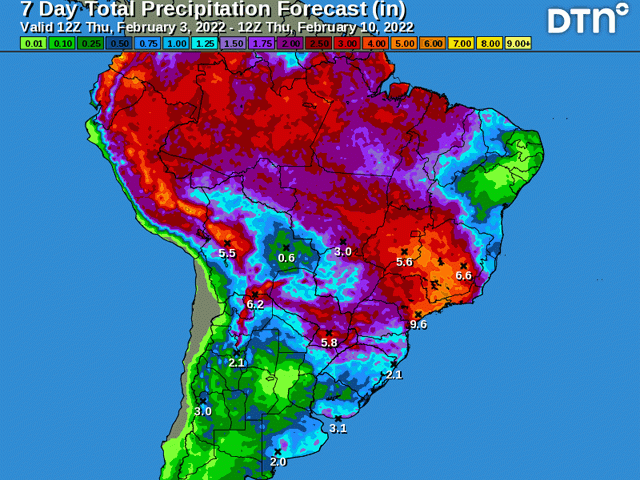South America Calling
Momentum Lost in Argentina Crop Conditions
Rains in January were quite good to Argentina. Rainfall amounts of 75 to 150 millimeters (roughly 3 to 6 inches) with isolated cases up and over 200 mm (roughly 8 inches) fell in a 12-day stretch between Jan. 15-26. These areas did see some improvement in the crop conditions for both corn and soybeans in last week's report from the Buenos Aires Exchange, but the increases were somewhat trivial. Good-to-excellent ratings rose 10 percentage points in corn and 8 percentage points in soybeans. The turnaround was only significant in that the trend had been sharply downward since the beginning of December.
But the new report from the Buenos Aires Exchange, released Feb. 3, paints a worse picture.
With rains shutting down Jan. 26 and being absent through Feb. 1, combined with temperatures approaching 40 Celsius (104 Fahrenheit) on occasion during that time frame, crop conditions fell back again.
Good-to-excellent ratings for corn fell from 32% to 28%. For soybeans, it was not as severe, with ratings dropping just one percentage point from 38% to 37%.
Southern Brazil has also been in drought with significantly high temperatures, and crop conditions have worsened in these areas as well.
P[L1] D[0x0] M[300x250] OOP[F] ADUNIT[] T[]
The Department of Rural Economics (Deral) in Parana, Brazil rates first crop corn at 38% good and soybeans at 36%. The state is responsible for roughly 15% of total corn and soybean production in Brazil, a significant state. These two crops are too far into development to benefit from increased rainfall and the ratings are remarkably similar to those in Argentina. Considering weather conditions have been fairly similar throughout the season, this is not a surprise.
Second-crop (safrinha) corn is a much larger portion of the state's total corn crop, estimated around 85% of production. As the soybeans are harvested, the corn is quickly planted. Safrinha corn, which is only 5% planted as of Jan. 27, was rated as 89% good. Recent rains have been able to bring back some of the moisture into this region of the country, and that will bode well for the safrinha corn, but only if the rains do not go absent again. Since this report was released, drier conditions have taken to the state, just like in Argentina, and the outlook for the month of February is not favorable.
Though La Nina conditions are relaxing a little bit in the short-term, it will still be a significant factor in global weather for months to come as conditions do not go into a neutral state until May or June according to most models. As discussed before, La Nina conditions generally cause dryness for Argentina and southern Brazil, and have certainly done so this season. You can read more about La Nina and its impacts by DTN's Bryce Anderson here: https://www.dtnpf.com/….
Long-range forecast models and DTN experts agree that the outlook for February is for drier conditions for this part of the world. That does not mean that it will be completely dry, however.
Showers have already moved into Argentina Feb. 2 and 3 and will be spreading into southern Brazil later in the day on Feb. 3 as well. These showers are spotty, however, and only limited areas are going to see amounts greater than 25 mm (about 1 inch). Up in Parana, the showers may be a little more intense, with amounts up to 50 millimeters more likely. The showers will be around the region through Feb. 5-6 before getting swept northward by a cold front and another dry stretch resumes for five-to-seven days next week.
The lower forecast amounts have been expected for a while, but the timeliness may be more important going forward. For those crops that have already sustained damage, scant showers will not be able to reverse it. We saw that heavy rain could not even reverse it. But showers every few days could keep temperatures down a bit and give enough moisture for later-planted corn and soybeans in Argentina and safrinha corn in Brazil to have some hope for decent production.
After the five- to seven-day dry stretch of dryness, another few days of showers looks to move back in. Will these showers and the periods that follow be enough to sustain crop growth for the rest of the season? We will need to keep checking on those crop reports out of both countries to find out.
To find more international weather conditions and your local forecast from DTN, head over to https://www.dtnpf.com/…
John Baranick can be reached at john.baranick@dtn.com
(c) Copyright 2022 DTN, LLC. All rights reserved.





Comments
To comment, please Log In or Join our Community .